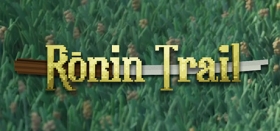
Developer Interview: Rōnin Trail
Recently, I found an incredible game on Kickstarter — called Rōnin Trail — that honours much of what it felt like to be a rōnin back in Japan’s post-war days. Not only is the game pretty amazing-looking, I feel like the developer (who goes by the username Devpachii) has really poured his heart and soul into the project. Thankfully, he agreed to have an interview with me! So, here are our questions.

How did you think of making a story about a samurai post-war?
I was always a big fan of samurai from movies and shows I watched as a kid. I liked Kurosawa films, The Last Samurai, as well as anime like Samurai Champloo, so I always wanted to create a samurai-themed game. My main inspiration for the post-war setting was the manga Vagabond, which follows the life of Miyamoto Musashi after the Battle of Sekigahara. He was a rōnin, and I felt like making a game roughly based on his life would be interesting.
What about the rōnin inspired you so much that you had to honour them through a game?
I liked the fact that rōnin were wanderers and untethered to any obligations. Unlike samurai, rōnin had lost their masters and had no idea what to do with their lives. It's not exactly a good term, and [it] has a bad connotation in Japanese; however, I felt like it would be an interesting idea to make a game out of. Rōnin wander the land searching for new purpose, and some choose to undergo a Musha Shugyo, or warrior’s pilgrimage, where they travel the land to discover new sword techniques and hone their skills. I felt like this would be a fun concept to make a game out of.
I can only imagine creating the game must've taken a lot of research. Will history buffs find little winks of the era?
I've done research, but I'm [by] no means an expert in the subject. The game has [a] historical background; however, it's still a game, and I don't think it's good to be too bound in realism. I'm planning to add many things that are not exactly accurate to the time period, but rather the most interesting things from the overall era of samurai. I do, however, want to keep sword fighting to be accurate to real kenjutsu and kendo techniques. I'm a kendo practitioner myself and seeing poor form or technique in games and movies really hits a nerve with me. I want to make a game where even the experts in sword fighting would be satisfied with it.

Building on the previous question, how did you approach the topic of research for this?
For historical background in Japan, I just use the internet or base things from pop culture media like Vagabond. I model buildings on images I find on Google from the time period. For sword fighting techniques, I learn basic kendo and kenjutsu kata techniques from my kendo club, and watch sword fighting demonstrations on YouTube for other techniques.
What has been the biggest challenge you've encountered during the development of the game (creativity block, bugs, budgeting, etc.)?
Creating buildings and 3D models has been the most time-consuming and challenging part for me. The part I enjoy is making fun combat and interactive environments, but creating buildings from scratch to fit the art style has taken the most time. As I continue to populate the open world, it will be challenging, but I'll have to keep working hard.
What has been your favourite part about developing Rōnin Trail?
Definitely making the combat system feel as satisfying as possible. I really wanted to make a system that I would never get tired of playing around with, and I think I'm happy with how it is now. Attacks in the game are fluid and allow you to turn freely while you strike. The stances are also a fun way to mix up combos and adapt to different situations. The blood and dismemberment system also adds to the realism of a fight since it really feels like you're dealing damage to your opponent.

The game's concept is quite unique. Have you drawn inspiration from other titles to put it together?
My main concepts for the game come from Breath of the Wild for the open world and beautiful environments to explore. I also like Sekiro for the combat and enemies, as well as Animal Crossing for the bug-catching and fishing aspect.
What influenced the graphic choice?
I chose to use voxels, since it was easy and quick to create new models for the game using MagicaVoxel. I also like the simplicity of voxels and pixels in games, so I based the game's art style on that. It makes it a lot easier for a solo developer to make models that way too.
Do you plan to form a team or continue developing solo?
I'm planning on continuing solo; however, I'd like to do collaborative work with artists, musicians, and sound designers, to help with development.
Once the game is out, what are your plans moving forward? Will you continue game development?
Rōnin Trail is more of a passion project than a game for me, so I don't think I'll ever really want to quit developing it. After the game is released, I'd like to keep adding content and new areas to it. I have so many ideas for interesting areas, like snow-covered mountain hot springs and beach areas, that I'll probably continue to develop new areas to explore after the initial release.

Check out Rōnin Trail on Steam and follow Devpachi on Twitter for more on the game’s progress! Additionally, feel free to leave a comment below with a question you might’ve liked to see in this interview. Thanks again for reading!









COMMENTS
cool drawing - 05:44am, 23rd July 2022
This website cool